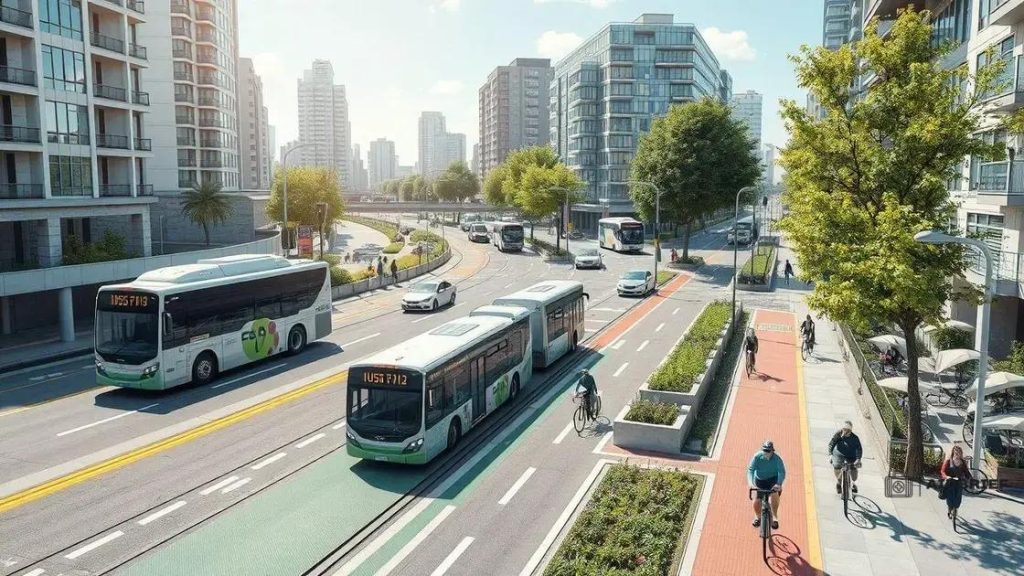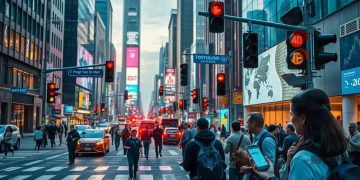Global trends in sustainable urban mobility: what’s next?

Global trends in sustainable urban mobility focus on innovative technologies like electric vehicles, smart traffic systems, and active transportation, aiming to improve efficiency, reduce emissions, and enhance community well-being.
Global trends in sustainable urban mobility are changing the way we think about city transportation. Are you ready to discover how these innovations can benefit our urban spaces?
Emerging technologies in urban mobility
New technologies are transforming urban mobility in remarkable ways. These innovations not only improve how we travel but also promote sustainability. Urban areas worldwide are embracing electric vehicles, smart traffic systems, and more. Let’s dive into some of the key technologies shaping our cities.
Electric Vehicles (EVs)
One of the most notable trends is the rise of electric vehicles. EVs reduce emissions and are becoming more accessible. Many cities are establishing charging stations, making it easier for people to switch. As battery technology enhances, we are likely to see even longer ranges, allowing for more extensive urban use.
Smart Traffic Management
Another exciting advancement is smart traffic management. This technology uses sensors and data to optimize traffic flow. It can reduce congestion and minimize travel time. Cities can adapt and respond quickly to traffic patterns, improving overall efficiency. Here are some key benefits of smart traffic systems:
- Reduces travel delays and emissions.
- Enhances safety for pedestrians and drivers.
- Provides real-time data for better decision-making.
Public transportation is also evolving with technology. Apps allow users to track buses and trains in real-time, improving reliability. People are more likely to use transit when they know when to expect their ride.
Autonomous Vehicles
Many companies are testing autonomous vehicles that promise to change urban landscapes. These vehicles can reduce accidents and optimize traffic flow. As regulations evolve, we could see more of these vehicles integrated into urban transport systems. Cities that adopt this technology could see significant improvements in mobility.
Moreover, shared mobility services are gaining popularity. Instead of owning cars, people can utilize rideshare, carpooling, and bike-sharing services. This shift reduces the number of vehicles on the road and encourages a more environmentally friendly approach to getting around.
Conclusion
Emerging technologies in urban mobility indicate a promising future for cities. As these innovations continue to develop, they hold potential to make urban transport more sustainable and efficient.
The importance of public transportation
Public transportation plays a key role in enhancing urban mobility. It offers a reliable way for people to travel efficiently within cities. With increasing populations in urban areas, public transit helps alleviate traffic congestion. Using buses and trains, individuals can move quickly and reduce the number of cars on the road.
Benefits of Public Transportation
There are many reasons why public transportation is vital for cities. First, it is cost-effective for individuals. Taking a bus or train is often much cheaper than owning a car. Here are a few more benefits:
- Reduces greenhouse gas emissions.
- Decreases traffic congestion.
- Improves access to jobs and education.
Moreover, public transportation supports social equity. It provides access for those who might not own a vehicle, ensuring everyone can participate in community life. Reliable transit systems allow people from various backgrounds to reach work, school, and essential services.
Impact on the Environment
Using public transportation also has a positive impact on the environment. When more people opt for buses and trains instead of cars, it leads to fewer emissions. Cities can combat air pollution and contribute to a healthier atmosphere for everyone. This shift is crucial as global climate challenges continue.
Furthermore, effective public transport systems can lead to economic growth. When people can commute efficiently, they can access more job opportunities. This economic boost can result from increased productivity and lower transportation costs for businesses.
Challenges to Enhance
Despite these advantages, some challenges remain. Aging infrastructure and lack of funding often hinder improvements. Cities must prioritize investments in public transportation to keep up with demand. Building more accessible systems is vital to ensuring everyone can benefit.
Active transportation: cycling and walking

Active transportation, such as cycling and walking, is becoming more popular in cities. These modes of travel are not only healthy but also environmentally friendly. As urban areas grow, promoting these activities can help reduce traffic congestion and improve air quality.
The Benefits of Cycling
Cycling offers numerous advantages for individuals and communities. It promotes physical fitness, allowing people to stay active while commuting. Additionally, cycling helps decrease the reliance on motor vehicles. Here are some benefits of cycling:
- Improves cardiovascular health.
- Reduces traffic congestion.
- Decreases carbon emissions.
When more people cycle, cities witness less pollution and easier traffic flow. This shift not only enhances public health but also makes urban areas more enjoyable for everyone.
Walking as Transportation
Walking is another vital form of active transportation. It is accessible to almost everyone and requires no special equipment. Walking can improve mental health by reducing stress and enhancing mood. Investing in pedestrian-friendly infrastructure encourages more people to walk for short trips.
Additionally, cities can create safer walking environments by:
- Installing adequate lighting.
- Creating more sidewalks and crosswalks.
- Implementing traffic calming measures.
These improvements make walking a more appealing option. When residents can easily walk to shops, parks, and schools, it fosters a sense of community and encourages social interaction.
Combining Modes of Transportation
Many cities are promoting a combination of active transportation and public transit. For example, bike-sharing programs and pedestrian-friendly transit stations can coexist. This integration allows people to use bikes to reach transit points, creating a seamless travel experience.
By promoting both cycling and walking, cities are taking significant steps toward a more sustainable urban mobility future. These modes of transportation not only enhance individual health but also contribute to community well-being. As cities adapt, the goal is to create safer, more accessible environments for everyone.
Challenges in implementing sustainable practices
Implementing sustainable practices in urban mobility faces several challenges. These obstacles can hinder the growth of eco-friendly transportation solutions. Identifying key issues can help city planners and policymakers develop effective strategies.
Funding and Investment
A significant challenge is the need for adequate funding. Many cities struggle to allocate resources for sustainable projects. Investing in public transit, bike lanes, and pedestrian paths requires financial commitment. Without sufficient funding, planned initiatives may stall or be reduced in scope.
Public Acceptance
Another challenge is gaining public acceptance of new sustainable practices. Some individuals are resistant to changing their commuting habits. They may prefer the convenience of personal vehicles. Educating the public on the benefits of sustainable transportation is crucial for encouraging acceptance.
Infrastructure Development
Developing the necessary infrastructure to support sustainability also presents difficulties. Building bike lanes, expanding public transport options, and enhancing pedestrian facilities require careful planning. There may be land use conflicts, outdated road networks, or bureaucratic hurdles to overcome. All of these factors can slow progress.
Policy and Regulation
Effective policy and regulation are essential for implementing sustainable practices. Yet, navigating the political landscape can be complex. Different stakeholders may have conflicting interests, making it hard to reach consensus. Policymakers must create clear guidelines that promote sustainability while addressing the needs of all parties involved.
Moreover, many cities face technological barriers. Adopting new technologies for sustainable transport requires training and resources. Some city officials may be unfamiliar with these advancements, making the transition slower. However, overcoming these challenges can lead to cities that prioritize sustainable urban mobility and improve the quality of life for residents.
Future predictions for urban mobility
The future of urban mobility is rapidly evolving as cities adapt to new challenges and opportunities. Emerging technologies and innovative solutions promise to transform how we move around urban areas. Understanding these predictions can help us prepare for the changes ahead.
Increased Adoption of Electric Vehicles
Electric vehicles (EVs) are likely to dominate urban transportation. With advancements in battery technology, EVs are becoming more affordable and convenient. Cities will see more charging stations, making it easier for people to switch from traditional cars. As EV adoption grows, we can expect a significant reduction in greenhouse gas emissions.
Integration of Smart Technology
Another exciting trend involves the integration of smart technologies into urban mobility systems. Intelligent traffic management systems can improve traffic flow and enhance safety. Real-time data from sensors and applications will help commuters plan their journeys efficiently. The future will likely include:
- Connected vehicles communicating with infrastructure.
- Data-driven approaches to optimize transport routes.
- Advanced traffic signals that adapt to current conditions.
These improvements will make urban transport systems more efficient and responsive to user needs.
Expansion of Public Transit Options
We can also expect a growth in public transit options. Cities will focus on creating multi-modal transport networks that combine buses, trains, and bike-sharing. This approach encourages people to rely less on personal vehicles. The increased accessibility of public transit will open opportunities for those who have limited mobility.
Emphasis on Sustainability
The emphasis on sustainability will drive cities to prioritize active transportation, such as walking and cycling. More bike lanes and pedestrian-friendly areas will be developed. Communities will invest in green spaces and encourage outdoor activities. This focus on health and the environment will make urban living more enjoyable.
In addition, cities might adopt new policies to support sustainability efforts. Incentives for carpooling, public transportation usage, and other eco-friendly commuting methods will likely play a significant role in shaping urban mobility.
As cities embrace technological advancements and prioritize sustainability, the urban mobility landscape will undergo significant changes. It is essential for city planners and residents to stay informed and adapt to these evolving trends.
Conclusion
In conclusion, the future of urban mobility is bright and full of potential. As cities work to embrace electric vehicles, smart technologies, and sustainable practices, they will create opportunities for healthier and greener living. The integration of active transportation will not only improve air quality but also promote community interaction. Policymakers and residents must collaborate to overcome challenges and pave the way for a better urban environment. By doing so, urban areas can thrive through innovative and sustainable mobility solutions.
FAQ – Frequently Asked Questions about Sustainable Urban Mobility
What are the benefits of electric vehicles in urban mobility?
Electric vehicles help reduce greenhouse gas emissions and are becoming more accessible, leading to cleaner air in cities.
How does smart technology improve transportation systems?
Smart technology optimizes traffic flow and enhances safety by using real-time data to manage transport effectively.
Why is promoting active transportation important?
Encouraging walking and cycling improves public health, reduces carbon emissions, and fosters a sense of community.
What challenges do cities face in implementing sustainable practices?
Cities often struggle with funding, public acceptance, and the development of necessary infrastructure to support sustainable initiatives.





